Optimizing Rice Irrigation Strategies to Maximize Water Productivity: A Simulation Study Using AquaCrop Model for the Yanyun Irrigation District, Yangzhou, China
Abstract
1. Introduction
2. Materials and Methods
2.1. Site Description and Data Collection
2.2. AquaCrop Model Description and Parameterization
- (1)
- Climate data: daily maximum and minimum air temperatures, (ETo) references, precipitation, and average annual carbon dioxide (CO2) are required for the AquaCrop model. For this study, 64 years of historical weather data (1955–2018) for the area were obtained from the China Meteorological Administration, including air temperatures, wind speed, sunshine hours, and mean relative humidity (RH). The ETo with FAO-56 Penman–Montith equation was used with these weather data. Climatic data are displayed in Figure 1a,b.
- (2)
- Soil data: the number of characteristics of the soil layer, soil composition, saturated volumetric water, field capacity, permanent wilting point, and saturated hydraulic conductivity are used in model operations. The soil layer in this analysis has loamy to silt-loam soil, according to the “Malvern 3000 laser” test, and soil samples were taken at depths of 0 to 20, 20 to 40, and 40 to 60 cm from each region Table 1. There were no impermeable or restrictive soil textures at the test site, which would have hampered root development. Without measuring hydraulic soil properties, the model calculates the respective values based on soil texture. In the event that certain properties are calculated, users can input the measured attributes into the model.
- (3)
- Crop data: days of transplanting, maximum canopy cover, flowering, the beginning of senescence, maximum rooting, and physiological maturity. The crop input parameters needed by AquaCrop for rice and user input are listed in Table 2. Rice is a grain-producing crop classified as C3 category. On the 23 June 2018, the seedlings were transplanted (row spacing: plant spacing = 33 cm:12.0 cm). Crop growth was measured, including leaf area index (LAI), biomass accumulation, and rice yields. For LAI measurement, the specific gravity method was used (randomly selected from each plant). To do so, 20 leaves were taken and a 10 cm length was cut for the specific gravity leaf. The average width of each leaf was measured to calculate the LAI [9]. CC was determined by using the relationship between LAI and CC Equation (4) [7] as:
| Parameters | Value | Unit | Default Value |
|---|---|---|---|
| Maximum canopy cover (CCx) | 98 | % | |
| Maximum effective root depth (Zx) | 0.5 | m | 0.4–0.6 |
| Recovery days after transplanting | 5 | days | |
| Days from transplanting to max canopy | 45 | days | |
| Days from transplanting to start senescence | 77 | days | |
| Days from transplanting to maturity | 110 | days | |
| Days of the flowering stage | 11 | days | |
| Normalized Water productivity (WP*) | 19 | gm−2 | 19 |
| Crop coefficient (Kctr) | 1.2 | 1.1 | |
| Reference harvest index (HIo) | 42 | % | 35–50 |
2.3. AquaCrop Model Calibration
2.4. AquaCrop Model Application
3. Results and Discussions
3.1. AquaCrop Model Performance
3.2. Predicted Water Balance of Paddy Fields under Different Irrigation Strategies
4. Conclusions
Author Contributions
Funding
Data Availability Statement
Conflicts of Interest
References
- Wu, W.; Ma, B.; Uphoff, N. A review of the system of rice intensification in China. Plant Soil 2015, 393, 361–381. [Google Scholar] [CrossRef]
- Xu, J.; Bai, W.; Li, Y.; Wang, H.; Yang, S.; Wei, Z. Modeling rice development and field water balance using AquaCrop model under drying-wetting cycle condition in eastern China. Agric. Water Manag. 2019, 213, 289–297. [Google Scholar] [CrossRef]
- Saadati, Z.; Pirmoradian, N.; Rezaei, M. Calibration and evaluation of aquacrop model in rice growth simulation under different irrigation managements. In Proceedings of the International Commission on Irrigation and Drainage ICID 21st Congress, Tehran, Iran, 15–23 October 2011. [Google Scholar]
- Maniruzzaman, M.; Talukder, M.S.U.; Khan, M.H.; Biswas, J.C.; Nemes, A. Validation of the AquaCrop model for irrigated rice production under varied water regimes in Bangladesh. Agric. Water Manag. 2015, 159, 331–340. [Google Scholar] [CrossRef]
- Raes, D.; Steduto, P.; Hsiao, T.; Fereres, E. Crop Water Productivity: Calculation Procedures and Calibration Guidance; AquaCrop Version 3.0; Land and Water Development Division; FAO: Rome, Italy, 2009. [Google Scholar]
- Geerts, S.; Raes, D.; Garcia, M. Using AquaCrop to derive deficit irrigation schedules. Agric. Water Manag. 2010, 98, 213–216. [Google Scholar] [CrossRef]
- Raes, D.; Steduto, P.; Hsiao, T.C.; Fereres, E. AquaCrop—The FAO crop model to simulate yield response to water: II. Main algorithms and software description. Agron. J. 2009, 101, 438–447. [Google Scholar] [CrossRef]
- Steduto, P.; Hsiao, T.C.; Fereres, E.; Raes, D. Crop Yield Response to Water; Food and Agriculture Organization of the United Nations: Rome, Italy, 2012; Volume 1028. [Google Scholar]
- Hu, Q.; Xia, M.; Zhang, H.; Cao, L.; Guo, B.; Wei, H.; Chen, H.; Huo, Z.; Xu, K.; Lin, C. Effect of nitrogen application regime on yield, nitrogen absorption and utilization of mechanical pot-seedling transplanting rice with good taste quality. Acta Agron. Sin. 2016, 42, 1666–1676. [Google Scholar] [CrossRef]
- Abdul-Ganiyu, S.; Kyei-Baffour, N.; Agyare, W.A.; Dogbe, W. Evaluating the Effect of Irrigation on Paddy Rice Yield by Applying the AquaCrop Model in Northern Ghana. In Strategies for Building Resilience against Climate and Ecosystem Changes in Sub-Saharan Africa; Springer: Berlin/Heidelberg, Germany, 2018; pp. 93–116. [Google Scholar] [CrossRef]
- Amiri, E. Calibration and testing of the Aquacrop model for rice under water and nitrogen management. Commun. Soil Sci. Plant Anal. 2016, 47, 387–403. [Google Scholar] [CrossRef]
- Bouman, B.; Tuong, T.P. Field water management to save water and increase its productivity in irrigated lowland rice. Agric. Water Manag. 2001, 49, 11–30. [Google Scholar] [CrossRef]
- Belder, P.; Bouman, B.; Cabangon, R.; Guoan, L.; Quilang, E.; Yuanhua, L.; Spiertz, J.; Tuong, T. Effect of water-saving irrigation on rice yield and water use in typical lowland conditions in Asia. Agric. Water Manag. 2004, 65, 193–210. [Google Scholar] [CrossRef]
- Heng, L.K.; Hsiao, T.; Evett, S.; Howell, T.; Steduto, P. Validating the FAO AquaCrop model for irrigated and water deficient field maize. Agron. J. 2009, 101, 488–498. [Google Scholar] [CrossRef]
- Amiri, E.; Rezaei, M.; Rezaei, E.E.; Bannayan, M. Evaluation of Ceres-Rice, Aquacrop and Oryza2000 Models in Simulation of Rice Yield Response to Different Irrigation and Nitrogen Management Strategies. J. Plant Nutr. 2014, 37, 1749–1769. [Google Scholar] [CrossRef]
- Shrestha, N.; Raes, D.; Vanuytrecht, E.; Sah, S.K. Cereal yield stabilization in Terai (Nepal) by water and soil fertility management modeling. Agric. Water Manag. 2013, 122, 53–62. [Google Scholar] [CrossRef]
- Paredes, P.; Wei, Z.; Liu, Y.; Xu, D.; Xin, Y.; Zhang, B.; Pereira, L.S. Performance assessment of the FAO AquaCrop model for soil water, soil evaporation, biomass and yield of soybeans in North China Plain. Agric. Water Manag. 2015, 152, 57–71. [Google Scholar] [CrossRef]
- Bello, Z.; Walker, S. Evaluating AquaCrop model for simulating production of amaranthus (Amaranthus cruentus) a leafy vegetable, under irrigation and rainfed conditions. Agric. For. Meteorol. 2017, 247, 300–310. [Google Scholar] [CrossRef]
- Pirmoradian, N.; Davatgar, N. Simulating the effects of climatic fluctuations on rice irrigation water requirement using AquaCrop. Agric. Water Manag. 2019, 213, 97–106. [Google Scholar] [CrossRef]
- Jamieson, P.; Porter, J.; Wilson, D. A test of the computer simulation model ARCWHEAT1 on wheat crops grown in New Zealand. Field Crops Res. 1991, 27, 337–350. [Google Scholar] [CrossRef]
- Paredes, P.; Torres, M.O. Parameterization of AquaCrop model for vining pea biomass and yield predictions and assessing impacts of irrigation strategies considering various sowing dates. Irrig. Sci. 2017, 35, 27–41. [Google Scholar] [CrossRef]
- Shao, D.; Le, Z.; Xu, B.; Hu, N.; Tian, Y. Optimization of irrigation scheduling for organic rice based on AquaCrop. Trans. Chin. Soc. Agric. Eng 2018, 34, 114–122. [Google Scholar]
- Seyed Raoufi, R.; Soufizadeh, S.; Amiri Larijani, B.; AghaAlikhani, M.; Kambouzia, J. Simulation of growth and yield of various irrigated rice (Oryza sativa L.) genotypes by AquaCrop under different seedling ages. Nat. Resour. Model. 2018, 31, e12162. [Google Scholar] [CrossRef]
- Ebrahim, A.; Hamidreza, A.A.; Aimrun, W.; Mojtaba, R. Simulation of rice yield under water and salinity stress in rasht area using aquacrop model. J. Teknol. 2015, 76, 21–28. [Google Scholar] [CrossRef]
- Andarzian, B.; Bannayan, M.; Steduto, P.; Mazraeh, H.; Barati, M.; Barati, M.; Rahnama, A. Validation and testing of the AquaCrop model under full and deficit irrigated wheat production in Iran. Agric. Water Manag. 2011, 100, 1–8. [Google Scholar] [CrossRef]
- Raes, D.; Geerts, S.; Kipkorir, E.; Wellens, J.; Sahli, A. Simulation of yield decline as a result of water stress with a robust soil water balance model. Agric. Water Manag. 2006, 81, 335–357. [Google Scholar] [CrossRef]
- Abdalhi, M.A.; Jia, Z.; Luo, W.; Ali, O.O.; Chen, C. Simulation of Canopy Cover, Soil Water Content and Yield Using FAO-AquaCrop Model under Deficit Irrigation Strategies. Russ. Agric. Sci. 2020, 46, 279–288. [Google Scholar] [CrossRef]
- Farahani, H.J.; Izzi, G.; Oweis, T.Y. Parameterization and evaluation of the AquaCrop model for full and deficit irrigated cotton. Agron. J. 2009, 101, 469–476. [Google Scholar] [CrossRef]
- Zeleke, K.T.; Luckett, D.; Cowley, R. Calibration and testing of the FAO AquaCrop model for canola. Agron. J. 2011, 103, 1610–1618. [Google Scholar] [CrossRef]
- Iqbal, M.A.; Shen, Y.; Stricevic, R.; Pei, H.; Sun, H.; Amiri, E.; Penas, A.; del Rio, S. Evaluation of the FAO AquaCrop model for winter wheat on the North China Plain under deficit irrigation from field experiment to regional yield simulation. Agric. Water Manag. 2014, 135, 61–72. [Google Scholar] [CrossRef]
- Wang, C.; Wang, S.; Chen, H.; Wang, J.; Tao, Y.; Liu, J. Evaluation of water-storage and water-saving potential for paddy fields in Gaoyou, China. Water 2018, 10, 1176. [Google Scholar] [CrossRef]
- Zhai, B.; Fu, Q.; Li, T.; Liu, D.; Ji, Y.; Li, M.; Cui, S. Rice irrigation schedule optimization based on the AquaCrop model: Study of the Longtouqiao irrigation district. Water 2019, 11, 1799. [Google Scholar] [CrossRef]
- Mohd, N.H.A.; Faiz, A.; Shyful, A.A.R.; Abdul, R.H.; Khairuddin, A.R. Evaluation of Aqua crop Model to Predict Crop Water Productivity. J. Inf. Syst. Technol. Manag. 2018, 3, 13–20. [Google Scholar]
- Pirmoradian, N.; Saadati, Z.; Rezaei, M.; Khaledian, M.R. Simulating water productivity of paddy rice under irrigation regimes using AquaCrop model in humid and semiarid regions of Iran. Appl. Water Sci. 2020, 10, 161. [Google Scholar] [CrossRef]
- Humphreys, E.; Li, T.; Gill, G.; Kukal, S. Evaluation of tradeoffs in land and water productivity of dry seeded rice as affected by irrigation schedule. Field Crops Res. 2012, 128, 180–190. [Google Scholar]
- Feng, L.; Bouman, B.; Tuong, T.; Cabangon, R.; Li, Y.; Lu, G.; Feng, Y. Exploring options to grow rice using less water in northern China using a modelling approach: I. Field experiments and model evaluation. Agric. Water Manag. 2007, 88, 1–13. [Google Scholar] [CrossRef]
- Jalil, A.; Akhtar, F.; Awan, U.K. Evaluation of the AquaCrop model for winter wheat under different irrigation optimization strategies at the downstream Kabul River Basin of Afghanistan. Agric. Water Manag. 2020, 240, 106321. [Google Scholar] [CrossRef]
- Machado, S.; Petrie, S.; Rhinhart, K.; Ramig, R.E. Tillage effects on water use and grain yield of winter wheat and green pea in rotation. Agron. J. 2008, 100, 154–162. [Google Scholar] [CrossRef]
- Cutforth, H.; McConkey, B.; Ulrich, D.; Miller, P.; Angadi, S. Yield and water use efficiency of pulses seeded directly into standing stubble in the semiarid Canadian prairie. Can. J. Plant Sci. 2002, 82, 681–686. [Google Scholar] [CrossRef]
- Gan, Y.; Campbell, C.; Liu, L.; Basnyat, P.; McDonald, C. Water use and distribution profile under pulse and oilseed crops in semiarid northern high latitude areas. Agric. Water Manag. 2009, 96, 337–348. [Google Scholar] [CrossRef]
- Jin, X.-L.; Feng, H.-K.; Zhu, X.-K.; Li, Z.-H.; Song, S.-N.; Song, X.-Y.; Yang, G.-J.; Xu, X.-G.; Guo, W.-S. Assessment of the AquaCrop model for use in simulation of irrigated winter wheat canopy cover, biomass, and grain yield in the North China Plain. PLoS ONE 2014, 9, e86938. [Google Scholar] [CrossRef]
- Zhao, Y.; Li, F.; Wang, Y.; Jiang, R. Evaluating the Effect of Groundwater Table on Summer Maize Growth Using the AquaCrop Model. Environ. Model. Assess. 2019, 25, 343–353. [Google Scholar] [CrossRef]

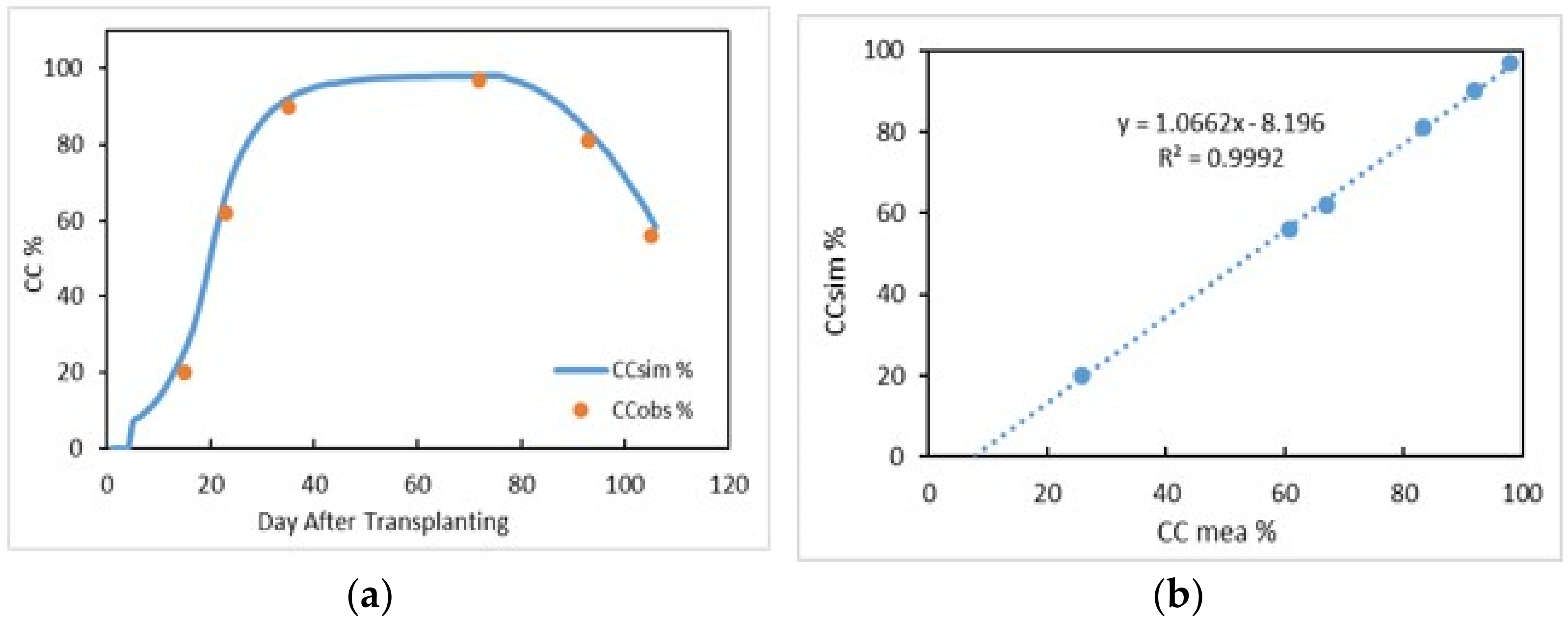
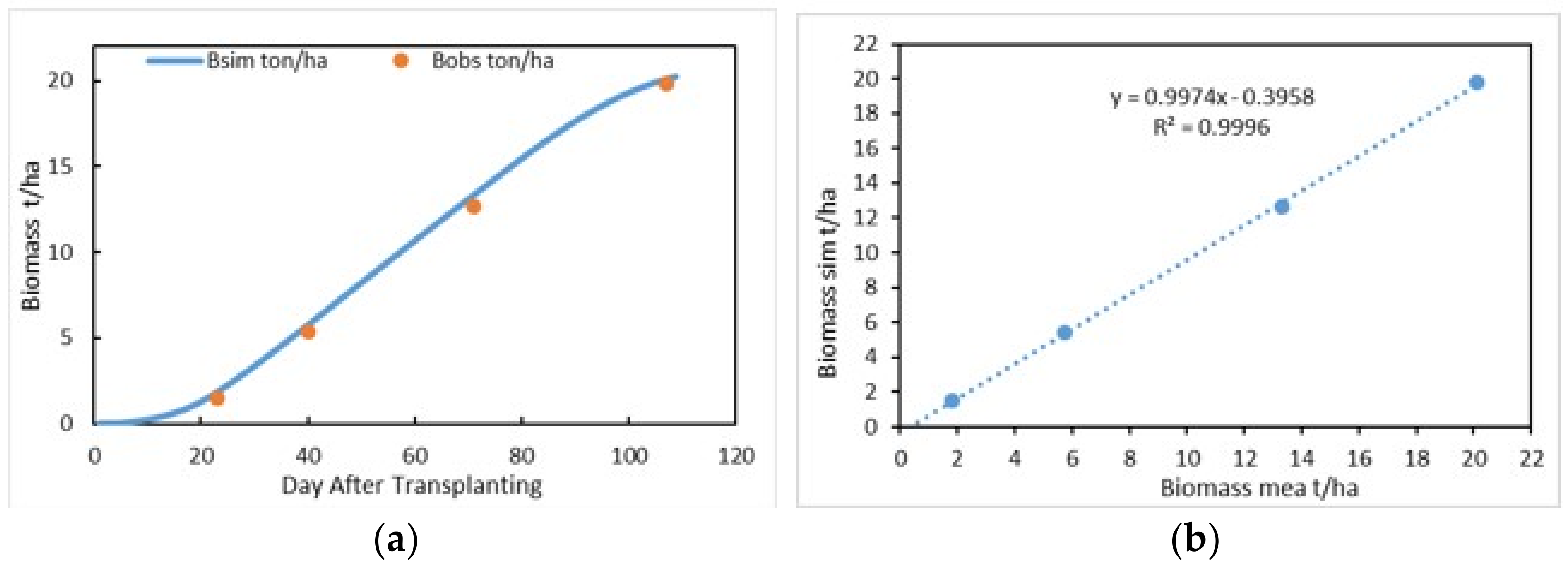
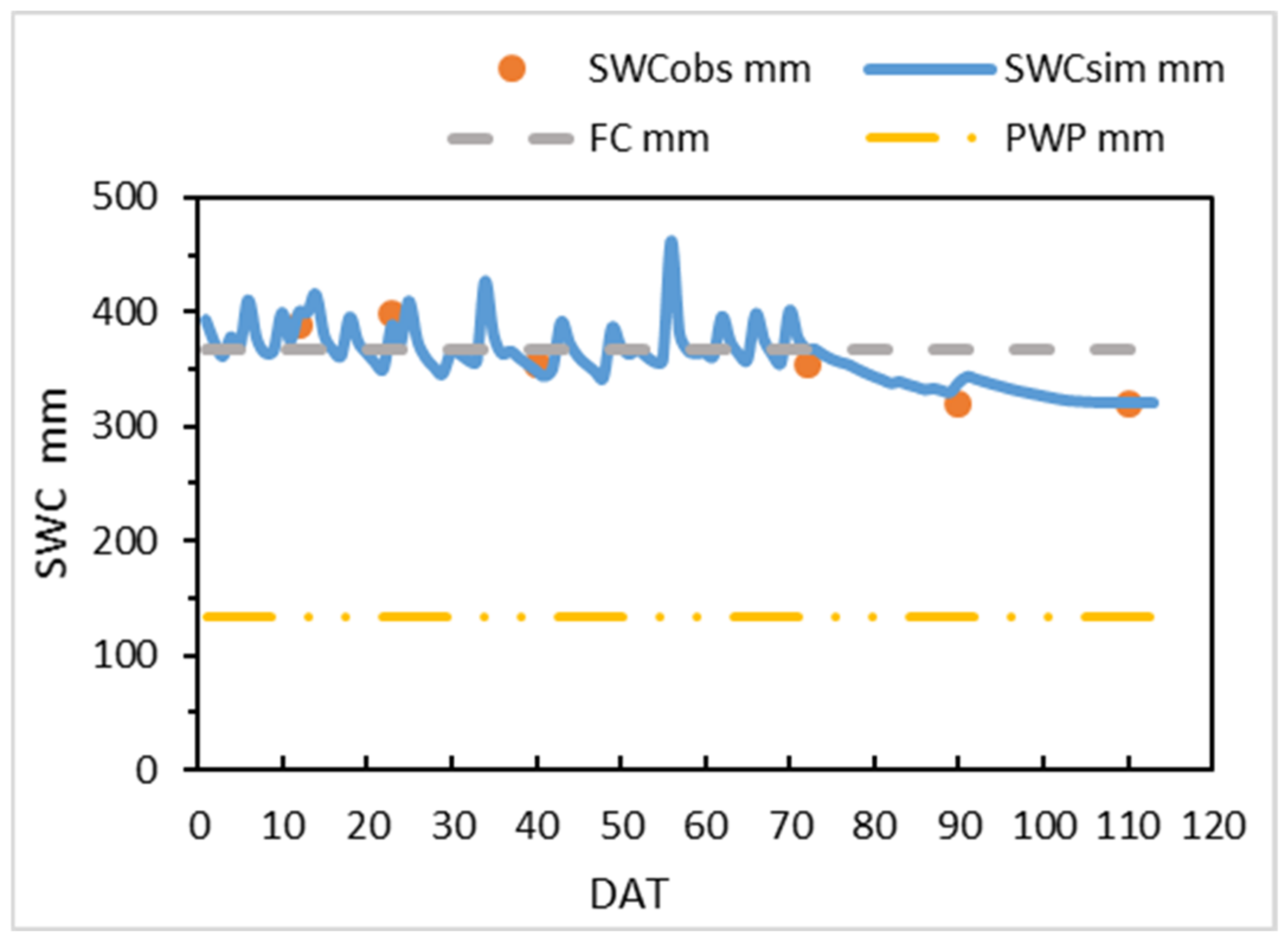
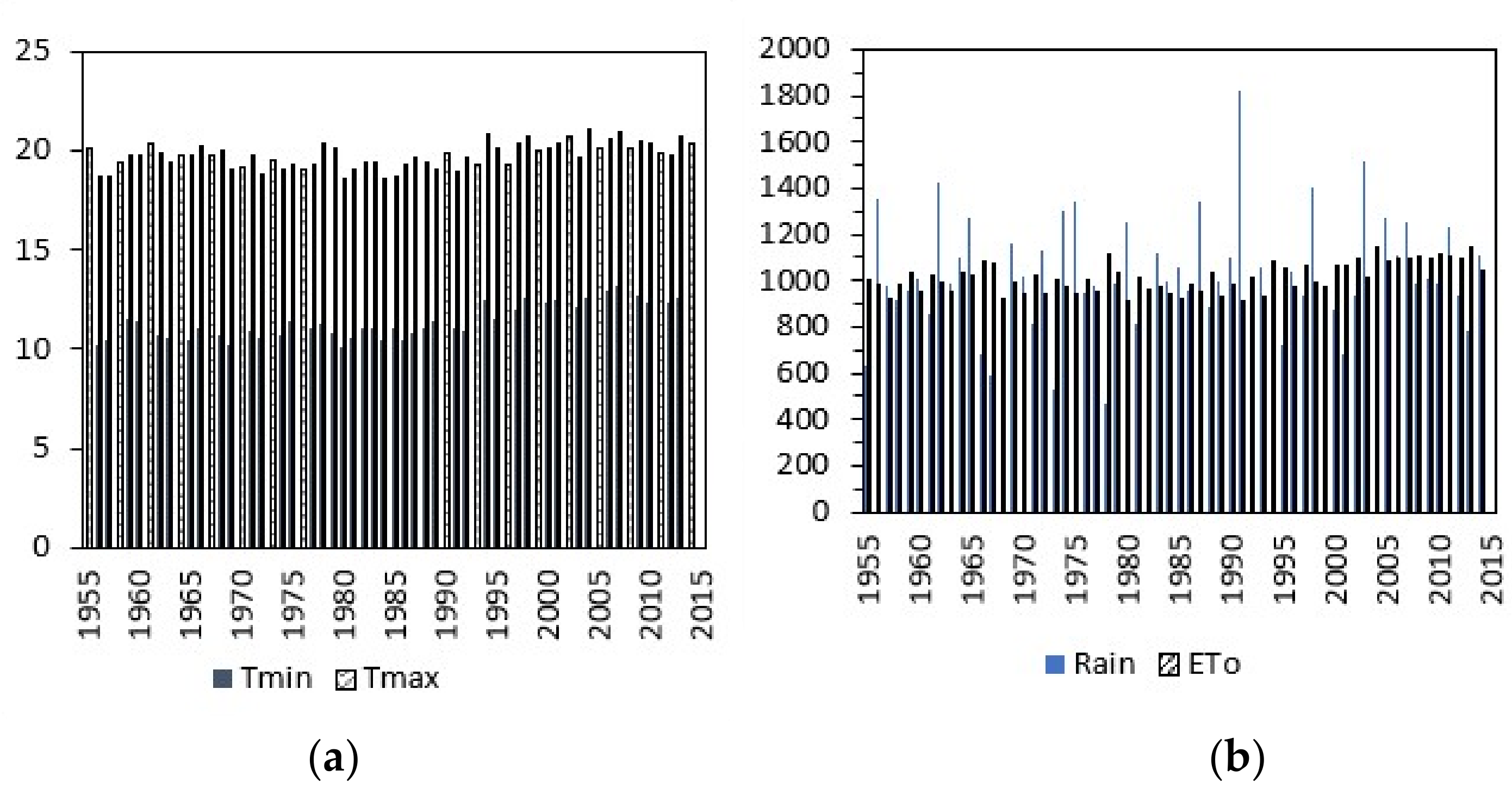
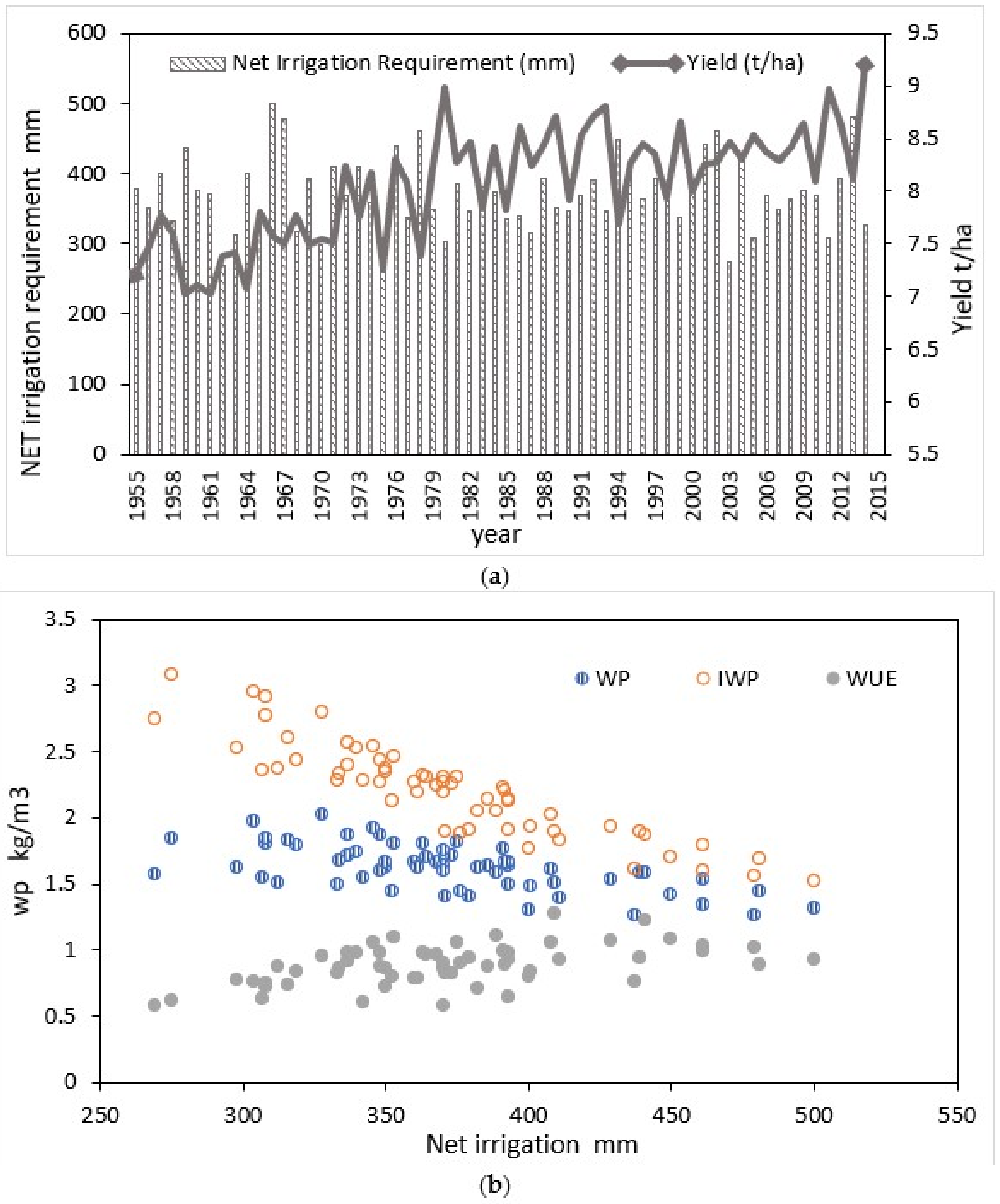
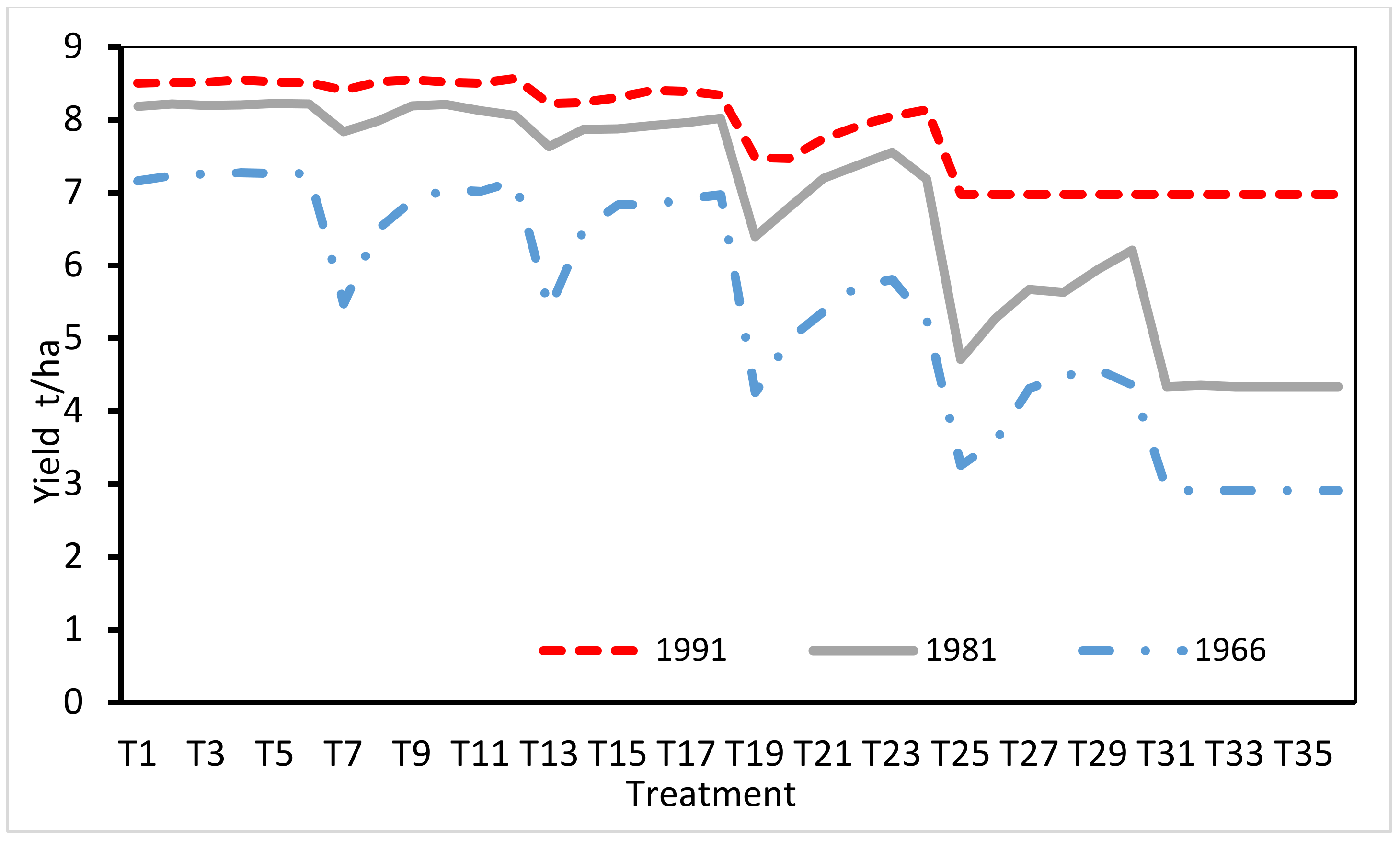


| Parameter | Depth cm 0–20 cm | Depth cm 20–40 cm | Depth cm 40–60 cm |
|---|---|---|---|
| Clay | 8.07% | 10.46% | 9.99% |
| Silt | 43.26% | 58.33% | 57.42% |
| Sand | 48.40% | 31.20% | 32.59% |
| Soil classification | loam | Silt loam | Silt loam |
| Field capacity | 42.07 cm3cm−3 | 35.24 cm3cm−3 | 35.10 cm3cm−3 |
| Wilting point | 15.0 cm3cm−3 | 13.0 cm3cm−3 | 13.0 cm3cm−3 |
| Saturated soil water content | 51.69 cm3cm−3 | 44.59 cm3cm−3 | 44.55 cm3cm−3 |
| Treatment | Rainfall mm | ETo mm | Irrigation Depth mm | % of Water Saved | Yield t/ha | Reduction in Yield% |
|---|---|---|---|---|---|---|
| wet year 1991 | ||||||
| Net Irr | 1084 | 462 | 370 | 8.53 | ||
| Irr 80% RAW | 160 | 57% | 8.52 | 0.09 | ||
| Irr 110% RAW | 120 | 68% | 8.51 | 0.21 | ||
| Irr 120% RAW | 80 | 78% | 8.4 | 1.5 | ||
| Irr 150% RAW | 40 | 89% | 7.91 | 7.25 | ||
| normal year 1981 | ||||||
| Net Irr | 564 | 493 | 386 | 8.28 | ||
| Irr 80% RAW | 200 | 48% | 8.2 | 0.94 | ||
| Irr 110% RAW | 180 | 53% | 7.98 | 3.62 | ||
| Irr 120% RAW | 160 | 59% | 7.86 | 5.01 | ||
| Irr150% RAW | 100 | 74% | 6.8 | 17.9 | ||
| dry year 1966 | ||||||
| Net Irr | 320 | 531 | 500 | 7.59 | ||
| Irr 80% RAW | 260 | 48% | 7.24 | 4.59 | ||
| Irr 110% RAW | 220 | 56% | 6.5 | 14.37 | ||
| Irr 120% RAW | 200 | 60% | 6.5 | 14.3 | ||
| Irr150% RAW | 120 | 76% | 4.98 | 34.33 | ||
| Crop | Exp. Year | WUE | WPet | IWP | References |
|---|---|---|---|---|---|
| rice | 2018 | in net irrigation 2.06 to 2.51 kg m−3 in deficit irrigation 1.58 to 2.57 kg m−3 | [33] | ||
| 2020 | for continuous flooding in humid 0.82 kg m−3 in dry 0.76 kg m−3 | [34] | |||
| 2012 | 1.66 g kg−1 | 1.81 g kg−1 | [35] | ||
| 2002 | 0.80 g kg−1 | [36] | |||
| 2003 | 0.36 g kg−1 | [36] | |||
| 2001 | 2.2 g kg−1 | in continuously flooded 0.2–0.4 g kg−1 in India and 0.3–1.1 g kg−1 in Philippines | [12] | ||
| pea | 2017 | 0.52–1.08 kg m−3 | 0.83–1.54 kg m−3 | 1.12–9.4 kg m−3 | [21] |
| wheat | 2020 | 0.58–0.66 kg m−3 | 1.4–1.5 kg m−3 | [37] | |
| 2008 | 0.65–1.72 kg m−3 | [38] | |||
| 2002 | 1.13 kg m−3 | [39] | |||
| 2009 | 0.39–0.65 kg m−3 | [40] | |||
| 2011 | In normal year 1.37–1.62 kg m−3 in dry year 0.47–1.73 kg m−3 | [25] | |||
| 2014 | 0.7–1.3 kg m−3 | [41] | |||
| maize | 2019 | 7.69–20.57 kg m−3 | [42] |
Disclaimer/Publisher’s Note: The statements, opinions and data contained in all publications are solely those of the individual author(s) and contributor(s) and not of MDPI and/or the editor(s). MDPI and/or the editor(s) disclaim responsibility for any injury to people or property resulting from any ideas, methods, instructions or products referred to in the content. |
© 2023 by the authors. Licensee MDPI, Basel, Switzerland. This article is an open access article distributed under the terms and conditions of the Creative Commons Attribution (CC BY) license (https://creativecommons.org/licenses/by/4.0/).
Share and Cite
Mostafa, M.; Luo, W.; Zou, J.; Salem, A. Optimizing Rice Irrigation Strategies to Maximize Water Productivity: A Simulation Study Using AquaCrop Model for the Yanyun Irrigation District, Yangzhou, China. Earth 2023, 4, 445-460. https://doi.org/10.3390/earth4030024
Mostafa M, Luo W, Zou J, Salem A. Optimizing Rice Irrigation Strategies to Maximize Water Productivity: A Simulation Study Using AquaCrop Model for the Yanyun Irrigation District, Yangzhou, China. Earth. 2023; 4(3):445-460. https://doi.org/10.3390/earth4030024
Chicago/Turabian StyleMostafa, Monera, Wan Luo, Jiarong Zou, and Ali Salem. 2023. "Optimizing Rice Irrigation Strategies to Maximize Water Productivity: A Simulation Study Using AquaCrop Model for the Yanyun Irrigation District, Yangzhou, China" Earth 4, no. 3: 445-460. https://doi.org/10.3390/earth4030024
APA StyleMostafa, M., Luo, W., Zou, J., & Salem, A. (2023). Optimizing Rice Irrigation Strategies to Maximize Water Productivity: A Simulation Study Using AquaCrop Model for the Yanyun Irrigation District, Yangzhou, China. Earth, 4(3), 445-460. https://doi.org/10.3390/earth4030024








